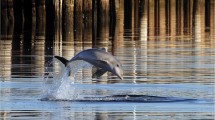Abstract
An adult male Australian sea lion (Neophoca cinerea) presented with a deep, almost circumferential, incised wound around the neck caused by a noose formed by a single strand of green nylon rope. The wound extended 4-5 cm deeply through the skin and blubber into skeletal muscle, predominantly on the dorsal surface and left side, but had not involved the airway or major vessels. The edges of the wound were sharply incised and oozing blood with a granulating infected base. The rope was removed and the wound debrided of necrotic tissues and irrigated with disinfectant. Antibiotic and rehydration therapy were successful and the seal was released after 2 weeks of treatment. Entanglement injuries such as “neck collars” have characteristic features, are increasing in incidence and often have lethal outcomes. This type of injury may significantly impact upon populations of pinnipeds in the wild.





Similar content being viewed by others
References
Byard RW, Kemper CM, Bossley M, Kelly D, Hill M. Veterinary forensic pathology: the assessment of injuries to dolphins at post-mortem. In: Tsokos M, editor. Forensic pathology reviews, vol. 4. Totowa: Humana Press; 2006. p. 415–33.
Kemper C, Flaherty A, Gibbs S, Hill M, Long M, Byard RW. Cetacean captures, strandings and mortalities in South Australia 1881-2000 with special reference to human interactions. Aust Mammalogy. 2005;27:37–47.
Byard RW, Machado A, Braun K, Solomon LB, Boardman W. Mechanisms of death in captive juvenile New Zealand fur seals (Arctocephalus forsteri). Forensic Sci Med Pathol. 2010;6:217–20.
Byard RW, Winskog C, Machado A, Boardman W. The assessment of lethal propeller strike injuries in sea mammals. J Forensic Legal Med. 2012;19:158–61.
Byard RW, Machado A, Woolford L, Boardman W. Symmetry – the key to diagnosing propeller strike injuries in sea mammals. Forensic Sci Med Pathol. 2013;9:103–5.
Gibbs SE, Kemper CM, Byard RW, Long M. Deaths of killer whales (Orcinus orca) in South Australia and implication of human interaction. Trans Roy Soc SA. 2004;128:231–7.
Gilbert JD, Kemper CM, Hill M, Byard RW. Forensic studies of a stabbed infant bottlenose dolphin. J Clin Forensic Med. 2000;7:150–2.
Byard RW, Gilbert JD, Kemper CM. Dolphin deaths: forensic investigations. Med J Aust. 2001;175:623–4.
Page B, McKenzie J, McIntosh R, et al. Entanglement of Australian sea lions and New Zealand fur seals in lost fishing gear and other marine debris before and after government and industry attempts to reduce the problem. Mar Poll Bull. 2004;49:33–42.
Colmenero AI, BarrÍa C, Broglio E, GarcÍa-Barcelona S. Plastic debris straps on threatened blue shark Prionace glauca. Mar Poll Bull. 2017;115:436–8.
Stelfox M, Hudgins J, Sweet M. A review of ghost gear entanglement amongst marine mammals, reptiles and elasmobranchs. Mar Poll Bull. 2016;111:6–17.
Franco-Trecu V, Drago M, Katz H, MachÍn E. With the noose around the neck: marine debris entangling otariid species. Environ Poll. 2017;220:985–9.
Carapetis E, Machado A, Byard RW. Lethal consequences of ingested foreign material in seabirds. Forensic Sci Med Pathol. 2010;6:242–3.
McIntosh RR, Kirkwood R, Sutherland DR, Dann P. Drivers and annual estimates of marine wildlife entanglement rates: a long-term case study with Australian fur seals. Mar Poll Bull. 2015;101:716–25.
Lawson TJ, Wilcox C, Johns K, Dann P, Hardesty BD. Characteristics of marine debris that entangle Australian fur seals (Arctocephalis pusillus doriferus) in southern Australia. Mar Poll Bull. 2015;98:354–7.
Allen R, Jarvis D, Sayer S, Mills C. Entanglement of grey seals Halichoerus grypus at a haul out site in Cornwall, UK. Mar Poll Bull. 2012;64:2815–9.
Hamer DJ, Goldsworthy SD, Costa DP, Fowler SL, Page B, Sumner MD. The endangered Australian sea lion extensively overlaps with and regularly becomes by-catch in demersal shark gill-nets in South Australian waters. Biol Conserv. 2013;157:386–400.
Waluda CM, Staniland IJ. Entanglement of Antarctic fur seals at Bird Island, South Georgia. Mar Poll Bull. 2013;74:244–52.
Boren LJ, Morrissey M, Muller CG, Gemmell NJ. Entanglement of New Zealand fur seals in man-made debris at Kaikoura, New Zealand. Mar Poll Bull. 2006;52:442–6.
Author information
Authors and Affiliations
Corresponding author
Ethics declarations
Ethical approval
Permission for publication was given by the Australian Marine Wildlife Research and Rescue Organization (AMWRRO).
Conflict of interest
The authors declare that they have no conflicts of interest.
Rights and permissions
About this article
Cite this article
Byard, R.W., Machado, A. Characteristic “neck collar” injuries in Australian sea lions (Neophoca cinerea) caused by marine debris. Forensic Sci Med Pathol 15, 631–634 (2019). https://doi.org/10.1007/s12024-018-0060-1
Accepted:
Published:
Issue Date:
DOI: https://doi.org/10.1007/s12024-018-0060-1




